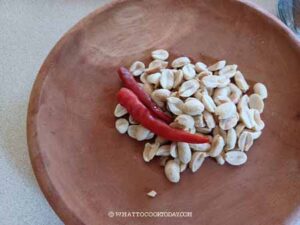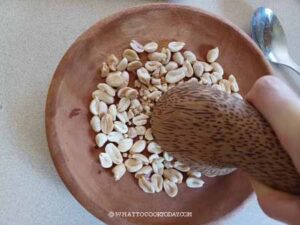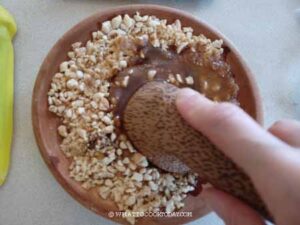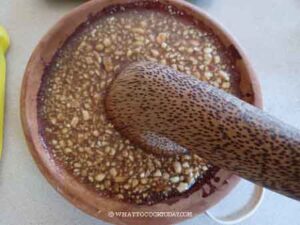This post may contain affiliate links. Please read our disclosure policy.
Refreshing fruit and veggie salad accompanied with Indonesian-style sweet, spicy, sour, and umami dressing. This is a popular street food loved by locals in Indonesia.

What is rujak uleg ?
Rujak uleg, a traditional Indonesian dish, originated in Java. It combines various fruits and sometimes vegetables with a spicy, sweet, and tangy sauce made from palm sugar, tamarind, peanuts, salt, shrimp paste (terasi), and chili peppers. The term “uleg” or sometimes written as “ulek”, refers to the traditional method of pounding or grinding the sauce ingredients using a mortar and pestle, which gives the sauce its rustic appearance, unique texture and flavor. The fruits commonly used in rujak uleg include green mango, pineapple, star fruit, unripe papaya, apples, guava, etc. Sometimes you will see cucumber, jicama, water spinach (kangkung), tauge (beansprouts) are added in the rujak too. It’s a popular street food in Indonesia and is enjoyed for its refreshing yet bold umami flavors.
Ingredients and substitutions
1. Fruits and vegetables
You can use whatever fruits and vegetables in seasons or fruit you like. These are common ones used in Indonesia: belimbing (star fruit), jambu (guava), pineapples, and green papaya. Vegetables: jicama, water spinach, tauge, string beans
2. Protein
Tofu and tempeh are common meatless proteins used in many Indonesian dishes. Don’t be surprised to see hard-boiled eggs too sometimes. You can skip the protein altogether if you want
3. Roasted peanuts
I use store-bought roasted unsalted peanuts. They are usually already skinless
4. Coconut sugar
Gula merah/gula Jawa/gula Melaka are more common in Southeast Asia. Coconut sugar is more common here. So that’s what I use. You can also use palm sugar or dark brown sugar. They are not the same but are quite similar in flavor.
5. Thai chili
This is to add spicyness to the dish. So you can skip or add more or less to your preference. If fresh Thai chili is not available, you can also use store-bought sambal oelek or any red chili sauce you like
6. Terasi
Terasi comes in a block form in Indonesia. If you can’t find terasi, you can use wet shrimp paste that comes in a jar.
7. Tamarind paste
Tamarind paste is available at Asian grocery stores. It has that sweet aroma and mild tanginess. If you can’t find any, you can substitute with lime juice or rice vinegar. They won’t be the same, but still add that nice tartness to the sauce
8. Salt
Salt is added to round up the overall flavor. So adjust to your taste

Rujak Uleg (Indonesian Fruit Salad)
Ingredients
Fruits and vegetables: (use what you like or in seasons)
- 250 g Persian cucumber
- 300 g jicama peeled
- 125 g star fruit
- 300 g pineapple
Protein: (optional)
- 200 g extra firm tofu
Bumbu kacang:
- 100 g roasted unsalted peanuts you can use salted peanuts too
- 5 red Thai chili more or less depending on your spicy tolerance
- ¼ tsp terasi optional
- 250 g coconut sugar
- ½ tsp salt adjust to your taste especially if you use salted peanuts
- 3 Tbsp tamarind paste
- 100 g water or more as needed
Instructions
Prepare the sauce: (can be done a few days before)
- The sauce can be prepared a few days ahead. It can be kept in the fridge for about a week and in the freezer for up to one month
- If you want a traditional way, use raw peanuts with skins. Preheat some oil over medium heat. Add the peanuts in and fry over medium-low heat. Fry until the peanuts are golden brown. It takes about 4-5 minutes. Control the heat to make sure they don't get burnt. Remove and place on absorbent paper towel
- I just use store-bought dry-roasted unsalted peanuts (for convenience)
- Terasi usually comes in a block. You can dry roast it on a pan for a minute or so to bring out the flavor. If you can't find terasi, you can also use shrimp paste that comes in a jar
- Place the peanuts, chili, terasi on a mortar.

- Use the pestle to grind the ingredients manually. This action is called "uleg/ulek" until they turn into coarse paste consistency. How coarse or fine you want the texture of the sauce is really up to you. I prefer to be able to still bite into some of the peanuts. So mine is much coarser and rustic in appearance

- Add the coconut sugar, salt, and tamarind paste to the mortar. If using gula Jawa/gula merah that comes in a block, cut or shave into small pieces. Add half of the water and manually grind again, adding water as needed.

- The sugar should be all dissolved as you uleg the mixture. How much water to add is really up to you. If you want the sauce to be thicker, you can add less water. If you want it runnier, just add more water. Simple as that

- Have a taste and adjust by adding more salt or chili or coconut sugar to your taste
- Serve it on a mortar with fruits and veggies. If you prepare ahead, transfer to a clean jar with a tight-fitting lid and store in the fridge for up to a week or in a freezer for up to one month
If you want to use tofu:
- I use extra-firm tofu that I cut into cubes. Pat them dry and toss with a bit of oil and then I air-fried at 375 F (190 C) for 5 minutes or until lightly golden brown. You can also pan fry with a bit of oil on the stove until lightly golden brown
Prepare the fruits and veggies:
- Cut the fruits into bite-size chunks or into slices. It's up to you. If you choose to use water spinach, beansprouts, and string beans, blanch them in boiling water for a minute or two and then remove from the boiling water and submerge into ice water or simply run cold water to over the veggies to stop the cooking process
- Arrange the fruits, veggies, tofu (if using), decoratively the way you know how on a large platter. Serve the sauce in the mortar for that authentic feel if you want.
How to store:
- The blanched veggies are best eaten on the same day if possible. Leftover fruits and uncooked veggies can be covered tightly with a cling wrap or stored in air-tight container in the fridge.
*Nutrition facts are just estimates and calculated using online tools*





